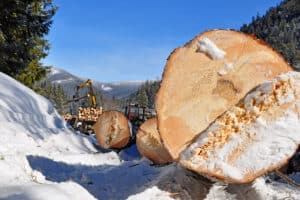Two feet of snow in 24 hours this past weekend called forth Shakespearean emotions–wonder, anger, despair, altruism, selfishness…and lower-back pain.
Blizzardy wipe out was a fitting way to close a decade that has made middle-class life increasingly precarious for ever larger numbers of middle-class people.
The Wall Street Journal’s Tom Lauricella wrote this week that the U.S. stock market “…is wrapping up what is likely to be its worst decade ever…in nearly 200 years.” Since the end of 1999, stocks on the New York Stock Exchange lost an average of 0.5 percent annually, spread out in a crash-boom-crash pattern.
The buying panics that inflated the decade’s bookend bubbles reflect, I think, the ever more common middle-class feeling that opportunities for gaining economic security are receding, not coming closer. These buying panics seem to be more about desperation than greed.
In uncertainty, people who still have investment money “revert to quality.” I see clients seeking such properties. They see 2009-2010 as a buy-low time for a five-year-plus investment horizon.
Investing, however, is out of reach if your money has been consumed by unemployment, underemployment, lack of credit, rising taxes, unmanageable health-care costs, soured speculations and markets that “disappeared” your savings and retirement.
I’m not old enough to remember the Depression, but the adjustments in expectations and behavior that beset everyone during those years are here. More and more of us are dragging along on government money in one form or another and occasional scraps of cash. We’re cutting—back, down and out. We’re stretching and scrimping, making do and doing without.
America’s economy found a reliable forward gear only after 1939 when the federal government started spending on national defense. Washington war money worked then, because it went directly into job-intensive manufactured goods. Manufacturing’s pump handle has gotten smaller and smaller during the last three decades. It will no longer lift the amount of economic water that it once did.
Most economists predict that some sort of normalcy will reappear at the end of 2010 or in 2011. But no one is saying that domestic manufacturing jobs will return, that wage scales from the middle down will rise or that individuals in their late 40s and older will be able to find work commensurate with their skills.
I think we’re heading into a hollowed-out recovery that will skip over those in the middle-class and blue-collar groups that need it most—the long-term unemployed, the underemployed, the underpaid, the inefficiently employed, older individuals and those who have been forced into marginal self-employment.
The official unemployment rate is said to be about 10 percent. If everyone above were counted as full-time-unemployment equivalents, I’d estimate the rate at between 20 and 25 percent.
Now, to be honest, my record of carefully observing the world around me is not the best. Take what happened yesterday.
My wife, Melissa, had attended an evening session two weeks earlier of something called, Color Me Beautiful. As I understand it, participants, typically women, are told that they are a particular season, which then determines “their” colors in clothing, cosmetics, hair and camouflage.
I’ve always thought Melissa looked best in blue or red, so my presents always dressed her like either a sailor or a fire truck.
Last night I was sitting on the living-room couch with my nose deep into the newspaper when Melissa comes home from work, walks to the dark part of the kitchen behind the refrigerator where I can’t see her, and says, “Notice anything?”
I mumble: “If the pages get any thinner, we’ll be able to see right through the news stories.”
“Have you noticed anything about ME….”
BIG-FAT-DANGER ALERT. I have missed some change in her appearance.
“…that started TWO WEEKS AGO?”
I fumble: “You’re taller.”
“No.”
“Thinner. Not that you needed to be.”
“No.”
“Your triceps are firmer. Your deltoids are bigger. Your toenail paint is oranger.”
“No. NO. NO.”
She walks over to the couch, dressed in her suit of courtroom armor.
“New shoes,” I say. “The bows are divine.”
“No.”
“New dress. Simple but complex.”
“No.”
“You have some black stuff around your eyes.”
“Yes.”
“You look like a raccoon.” It just came out.
I scramble: “Very fashionable that Lone Ranger look. Wonderful use of your new Eye Care Stick to highlight, lowlight and conceal. Your shadows are art. Vogue will be sending a photographer.”
“I…do not look like…a raccoon! And it’s not my eyes.”
“Chin?”
“No.”
“Ears?”
“No.”
“Lipstick?”
“NO!”
“Hair?”
Pause. “What about my hair?”
“Longer.”
“No.”
“Shorter? Curlier? Straighter? Fluffier? …Browner, that’s it. You colored it brown!”
“Do you like it?”
“I…I love it. It improves your whole…no, no. I mean it brings back your natural brunette. It’s not too brown-brown. It’s just-right brown. It’s a brown of a different color. It’s..it’s….”
“It’s Autumn, not brown.”
“Exactly the word I was searching for. Autumn. Yes indeed, Autumn. I can taste the crisp of the apple, smell the first wood fire, see the pile of compost getting higher, hear the fall of a single….”
“Oh, stop it. TWO WEEKS!”
And there it is. Proof beyond dispute that I am a keen observer of my environment, a man whose opinions — both predictive and interpretive — should be trusted.
My season, incidentally, is dog house. This is where I spent Saturday and Sunday shoveling my own beautiful color—snow white.
Individuals rarely succeed in carrying out New Year resolutions because we who make them are rarely capable of changing anything as tricky as our futures.
Everyone would have much more success if, instead, we simply resolved to improve what we’ve already said and done.
Accordingly, it is no longer true that I told my wife she looked like a raccoon.
And if anyone spoke words that might have sounded like those, it is because he was suffering from seasonal affective disorder that causes bone mass to accumulate between his ears. For which he cannot be held permanently responsible.
And in that spirit, I also pledge to behave better in the past than I ever did.
Welcome 2010.
This content may not be used or reproduced in any manner whatsoever, in part or in whole, without written permission of LANDTHINK. Use of this content without permission is a violation of federal copyright law. The articles, posts, comments, opinions and information provided by LANDTHINK are for informational and research purposes only and DOES NOT substitute or coincide with the advice of an attorney, accountant, real estate broker or any other licensed real estate professional. LANDTHINK strongly advises visitors and readers to seek their own professional guidance and advice related to buying, investing in or selling real estate.









Add Comment